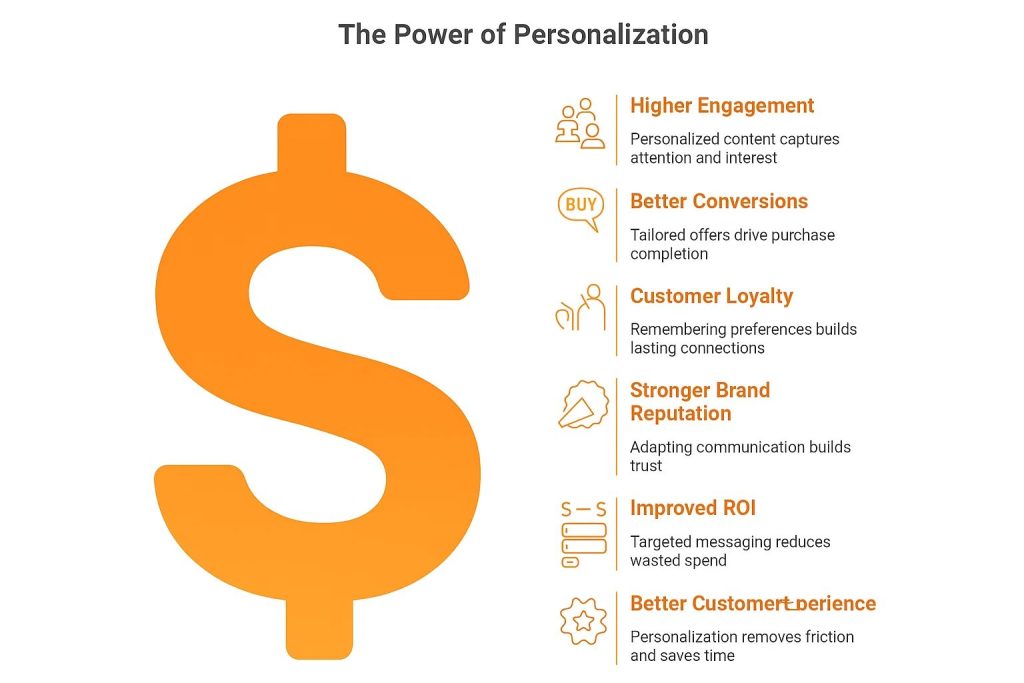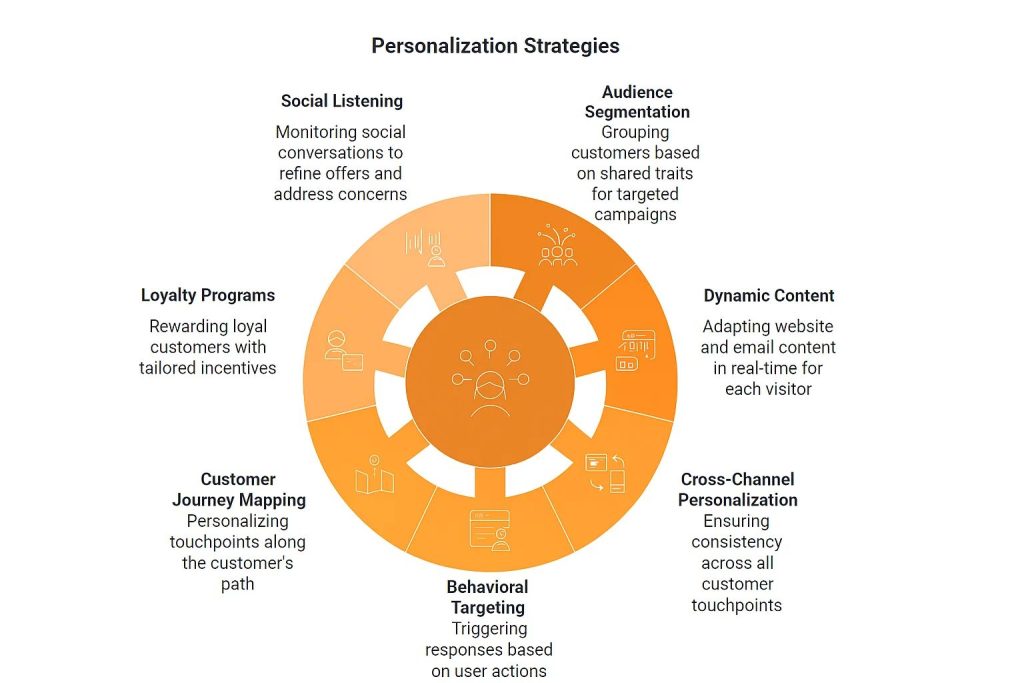Personalization in digital marketing is no longer a bonus, it’s what customers expect. Think about the last time Netflix lined up the perfect show for you, or when your favorite coffee app sent you a reward that felt like it was made just for you. That’s personalization at work, and it’s the reason some brands feel closer and more memorable than others.
People don’t want to be treated like a number. They want brands to recognize their habits, speak their language, and offer something that makes sense in the moment. When personalization is done well, it creates trust, drives sales, and keeps customers coming back. When it misses the mark, it feels pushy and out of touch.
This guide breaks down what personalization in digital marketing really means, why it matters, strategies to put it into practice, and the trends shaping its future.
What is personalization in digital marketing?
Personalization in digital marketing means tailoring content, offers, and customer experiences to individuals based on their data, behavior, and preferences. Instead of sending one generic message, you adapt your strategy so each person feels like the brand is speaking directly to them.
In simple terms: personalization is using what you know about a customer to give them what they actually want.
Why is personalization important in marketing?
People expect brands to understand them. A generic ad or email often gets ignored, but personalized experiences build trust and drive action. Studies show that:
- According to McKinsey, 71 percent of consumers expect companies to deliver personalized interactions, and 76 percent get frustrated when this doesn’t happen.
- Companies that excel at personalization generate up to 40% more revenue.
Benefits of personalization

Here are the key benefits businesses gain from marketing personalization:
Higher engagement
Personalized content speaks directly to a customer’s needs and interests, which makes them more likely to open emails, click ads, or spend time on your site. It cuts through the noise of generic messaging.
Better conversions
When people see offers or recommendations that match what they’re already looking for, they’re more likely to complete a purchase. Personalization shortens the path from interest to action.
Customer loyalty
Brands that remember preferences, birthdays, or buying habits create a sense of connection. Customers feel valued and keep coming back because the brand “gets them.”
Stronger brand reputation
Personalization shows that you pay attention. When a business adapts its communication instead of blasting the same message to everyone, it builds trust and positions itself as customer-first.
Improved ROI
Personalization reduces wasted spend on ads and emails that don’t resonate. By targeting only what matters to each segment, companies see higher returns without increasing costs.
Efficient lead nurturing
Retargeting feels less like spam when it’s relevant. Instead of chasing people with the same generic ad, personalization helps deliver reminders, recommendations, or content that feels useful and timely.
Better customer experience
Personalization removes friction by showing people what they want faster. Whether it’s Netflix suggesting the next show or an online store recommending the right product, customers save time and frustration.
Challenges of marketing personalization
While personalization is powerful, there are challenges businesses need to solve:
Strategies for effective personalization
While personalization is powerful, there are challenges businesses need to solve:
Data collection and integration
Customer information often comes from many sources—websites, apps, CRM systems, and social media platforms. If this data remains fragmented in silos, it’s nearly impossible to build a full customer profile. Without integration, personalization efforts become inconsistent and less effective.
Privacy and compliance
Laws like GDPR and CCPA require explicit consent for tracking and data use. This means brands must explain clearly what data they collect and why. Customers expect transparency and control, so crossing the line into invasive tracking can quickly damage trust.
Over-personalization
Personalization should feel helpful, not creepy. When brands reference overly specific details or private information, it makes people uncomfortable. For example, congratulating a customer on a life event they never shared directly can feel invasive and push them away.
Content volume
Effective personalization requires constant variation—emails, ads, product recommendations, and landing pages tailored to different groups. This demand for fresh content can overwhelm marketing teams if there isn’t a clear system in place.
Resource demands
Personalization isn’t plug-and-play. It requires investment in tools like CRMs, CDPs, and AI platforms, plus skilled people to manage them. Without proper planning, personalization projects can drain budgets and exhaust staff capacity.
Maintaining consistency
Customers don’t think in channels—they expect one continuous brand experience. If personalization is strong on email but generic on the website, or tailored in-app but missing in customer support, the inconsistency breaks trust and disrupts the journey.
Strategies for effective personalization

Personalization isn’t one-size-fits-all. Here are practical ways to implement it:
1. Audience segmentation
Group your customers based on shared traits like age, location, buying habits, or interests. Segmented campaigns perform better because messages feel more relevant. For example, a fitness brand can send one set of offers to beginners and another to advanced athletes, instead of sending the same email to everyone.
2. Dynamic content
Adapt your website and emails in real-time to match each visitor. This can include changing banners, product recommendations, or even call-to-action buttons. For instance, a returning customer might see a “Welcome back” message and tailored product suggestions, while a new visitor sees an introductory offer.
3. Cross-channel personalization
Customers move across channels, social media, email, SMS, websites, even in-store. Consistency matters. If someone abandons a cart online, they should receive a reminder email or see a relevant ad on social. A connected experience makes the journey smoother and builds trust.
4. Behavioral targeting & remarketing
Track user actions like browsing, cart activity, or past purchases to trigger timely responses. Example: retargeting an abandoned cart with a small discount can nudge buyers to complete their purchase. The key is balance, remind customers without spamming them.
5. Customer journey mapping
Map out the steps customers take from awareness to purchase. Identify key touchpoints, ads, social posts, landing pages, checkout, and personalize them. This ensures you guide people naturally, instead of forcing generic offers at the wrong stage.
6. Loyalty programs & tailored offers
Reward loyal customers with personalized incentives. This could mean sending birthday discounts, early access to products they like, or points for repeat purchases. Loyalty programs not only boost retention but also encourage customers to keep sharing their data in exchange for value.
7. Social listening
Monitor conversations about your brand, competitors, and industry on social platforms. Insights from social listening can help refine offers, respond quickly to customer concerns, and even predict future trends. For example, if customers consistently praise a feature, highlight it in your marketing; if they complain, address it directly.
The science behind personalized marketing
Personalization works because it combines data and technology to shape customer experiences. The main building blocks include:
Data collection
Everything starts with data. Brands gather details such as purchase history, browsing patterns, location, device type, and even social interactions. Together, these insights create a clearer picture of each customer’s needs and habits. Without accurate and up-to-date data, personalization can’t deliver meaningful results.
Segmentation
Once data is collected, customers are grouped into segments based on shared traits. For example, first-time visitors may need educational content, while repeat buyers expect rewards or upgrades. High-value customers might get exclusive offers. Segmentation ensures that every group receives content that feels relevant to their stage in the customer journey.
Recommendation engines
Algorithms analyze past behavior and preferences to suggest products, services, or content. This is why an online store recommends items “frequently bought together,” or a streaming service suggests shows similar to what you just watched. These engines create a sense that the brand “knows” the customer and saves them time by narrowing choices.
AI and machine learning
AI takes personalization further by predicting what customers might do next. It can forecast churn risk, anticipate purchases, and adapt content in real time. For example, if AI detects a customer is about to abandon their cart or switch to a competitor, it can automatically trigger a timely discount or incentive to keep them engaged.
A/B testing
Personalization should never be static. A/B testing allows brands to test variations of subject lines, images, offers, or website layouts to see which version performs better. This process of continuous refinement ensures that personalization strategies evolve with changing customer preferences and behaviors.
Real-world personalized marketing examples
Personalization isn’t theory, it’s already driving results for the world’s top brands:
- Amazon – Around 35% of Amazon’s sales come from its recommendation engine. By suggesting items “frequently bought together” or “customers also viewed,” Amazon keeps shoppers browsing and buying.
- Netflix – Uses advanced AI to recommend shows and even customize thumbnails based on your past viewing. This keeps people watching longer and increases subscription retention.
- Spotify Wrapped – An annual campaign that gives users a personalized summary of their listening habits. It sparks massive social sharing and strengthens loyalty, turning personalization into viral marketing.
- Coca-Cola “Share a Coke” – By printing names on bottles, Coca-Cola created a sense of ownership and personal connection. The campaign boosted sales worldwide and became a cultural moment.
- Starbucks app – Tracks purchase history to suggest drinks, reward customers with tailored offers, and remind them of seasonal favorites. This keeps visits frequent and loyalty strong.
- Nike By You – Lets customers design their own shoes. It combines personalization with creativity, giving people a product they feel uniquely connected to.
Avoiding pitfalls in personalization
Personalization is powerful, but it must be used carefully to avoid backfiring:
- Don’t over-personalize – referencing sensitive details or life events can feel invasive. Example: congratulating someone on a personal milestone they never shared directly.
- Respect privacy – always explain how data is collected and allow customers to opt out. Transparency builds trust, while hidden tracking erodes it.
- Keep the human touch – automation should make experiences smoother, not robotic. Personalization should still feel thoughtful, not just machine-driven.
- Test frequency – sending too many personalized ads or emails can overwhelm customers. A balanced approach ensures relevance without causing fatigue.
Future trends in personalization
Personalization is evolving fast. Here’s what’s shaping the next wave:
AI and predictive analytics
Instead of reacting only after a customer takes action, AI will increasingly predict what they’re likely to do next. Predictive analytics can flag when someone is at risk of leaving, estimate when they’re ready to purchase again, or suggest products before a customer even searches for them. This shift allows brands to be proactive, offering the right solution at the right time.
Contextual personalization
The next stage of personalization adapts not just to who the customer is but also to where and when they are engaging. Real-time data such as time of day, season, weather, or even nearby events will influence the messages people see. For example, a food delivery app might promote warm soups on a rainy evening or iced drinks on a hot afternoon.
Voice and personal assistants
With more people relying on Siri, Alexa, and Google Assistant, personalization must also adapt to voice-driven search and interactions. Instead of typing, customers are asking devices direct questions like “What’s the best coffee near me?” Brands that optimize for conversational, voice-friendly personalization will have an advantage.
Intent-based marketing
Traditional personalization looks at demographics and past behavior. The future focuses more on intent, what the customer is trying to achieve right now. By analyzing signals such as search queries, browsing context, and engagement patterns, brands can deliver offers at the precise moment someone is ready to decide.
Privacy-first personalization
Consumers are more aware of data privacy than ever, and regulations are growing stricter. The future of personalization lies in models that respect user control—offering opt-in options, anonymizing data, and being transparent about usage. Brands that can provide personalization without overstepping boundaries will build the strongest trust and loyalty.
Drive Growth in 2025 With Smarter Personalization
Your customers expect brands to understand their needs. Meeting that expectation means going beyond generic campaigns and building digital experiences that feel relevant at every step.
That’s where Effeect comes in. We craft marketing strategies designed to match your audience’s preferences and move them closer to action. Our team blends creativity with data-driven execution across:
- SEO
- Content Marketing
- Paid Advertising Campaigns
- Social Media Growth
- Email Campaigns That Convert
If you’re ready to personalize your marketing and turn attention into loyalty, let’s build your next strategy together.
Conclusion
Personalization in digital marketing isn’t a “nice-to-have” anymore, it’s expected. Brands that use customer data wisely create experiences that are relevant, trustworthy, and memorable. Done right, personalization boosts engagement, loyalty, and revenue while building stronger connections with your audience.
The bottom line: customers don’t want to feel like a number. They want to feel known. Personalization is the way to make that happen.
FAQs
How can I personalize marketing without crossing privacy lines?
Start with simple, non-intrusive steps. Let customers choose what they want to share, explain clearly why you’re asking, and give them easy opt-in or opt-out options. This builds trust while still giving you useful data.
What type of customer data is best for personalization?
The most reliable data is what customers give you directly, such as preferences, survey answers, or profile details. This is often called “zero-party data” and is safer and more accurate than relying only on third-party tracking.
How do businesses personalize at scale?
The key is automation. Using CRM or customer data platforms, you can manage profiles, segment audiences, and deliver tailored content across multiple channels. This keeps messaging consistent without overwhelming your team.
What are common mistakes in personalization?
Many brands overdo it or use too little data. Over-personalization can feel creepy, while under-personalization just looks generic. Another common issue is using disconnected tools that don’t share data, which creates inconsistent experiences.






